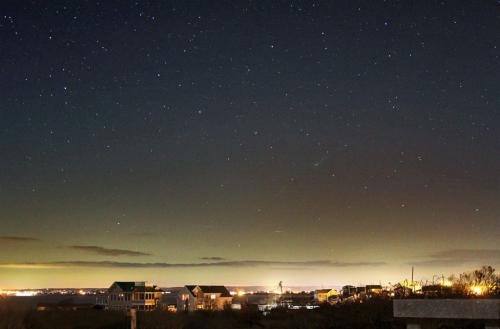Comet Lovejoy meets Venus
I had driven down to Point Judith, ostensibly to look for Comet Lovejoy. The previous week, Comet ISON, which the media had heralded as a possible comet of the century, dominated the conversation during Thanksgiving dinner. Hopes were raised that it would emerge from its rendezvous with the Sun and make good on that prediction. With much disappointment, ISON did not long survive that encounter. Yet, the astronomy community was abuzz with the prominence of several other comets, principal among them, Comet Lovejoy.
I had received a tweet that conditions would be favorable for viewing Lovejoy shortly after dusk that evening. Already dressed for the cold, I made my way to Narragansett in time for the early sunset, and a later meetup with a friend. Upon arriving, I talked to a lobsterman photographing the sunset, boat safely moored, who complained of being frozen to the core. He told me he liked having new experiences and learning new things, so we talked about comets and the sky.
As the sunlight blazed and then faded in the western sky, it became apparent that the west- northwest horizon would be a challenge to find Lovejoy in, as the light pollution from Galilee was conspicuous. The hope was that looking 14-degrees above the horizon toward the constellation Corona Borealis would yield a blurry spot, easily visible with binoculars. With the help of a laser light pointer indicating Lovejoy’s approximate position, I could just make out a blurry image, which kept coming in and out of view. I couldn’t be sure if this really was the comet, or the result of my eyes tearing from the cold. I kept at it for a long while, without much success.
With frustration building up, I surveyed the 360-degree view of the horizon from our position. The Point Judith lighthouse boldly flashed her beacon, and was answered in turn, lovingly and intermittently, by her Beavertail relative, further down the coast. The quarter Moon cast a bright shine on the ocean at a distance, as boats passed in the night. The wind whipped, and the waves crashed.
I aimed my glance toward the southwest.
There, I beheld an amazingly bright planet Venus, throwing her light breathtakingly and reflectively on the water in a line between her and myself, as if to say, “Come to me.”
I was transfixed.
After the Sun and the Moon, Venus is the third brightest object in the cosmos. Astronomers use the term “magnitude” to represent the brightness of objects in the sky. Numbers range from negative digits, to zero, to positive digits, with the negative digits representing the brightest objects. With an approximate magnitude of -4, Venus is about 2.5 times brighter than a -3 magnitude object, which is in turn 2.5 times brighter than a -2 magnitude object, and so on.
Outshining the brightest stars, I wondered if in fact it wasn’t Venus that I was wishing upon in my Brooklyn childhood as I recited “Star light, star bright, the first star I see tonight...”
And, like the proverbial girl next door you grew up with, but never noticed, who then matures into a beautiful woman, Venus was radiant and enrapturing that evening at Point Judith. At once a powerful presence in the sky, her soft glow on the water remained seductive. It was a sight to behold and to feel.
Like the frozen lobsterman I spoke to earlier, eager to experience something new, I experienced something novel and exciting, as well.
Standing in the cold and wintry blast of the night’s fury, my breath had come out as white clouds and hovered in the air.
The clouds slowly wafted upward and touched the face of Venus.
Then, Venus spoke to me, as she had never done before.
- Author:
- Mark Sweberg
- Entry Date:
- Feb 4, 2014
- Published Under:
- Mark Sweberg's Columns



